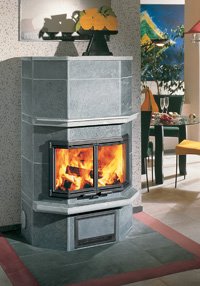Tulikivi soapstone fireplace from Scandinavia

Healthy Radiant Heat
Tulikivi Fireplaces Radiate a Pleasant Warmth
When you sit near a Tulikivi fireplace, you experience a pleasant feeling of warmth. This penetrating yet comfortable radiant heat is the same heat that travels to us from the sun as infra red light (infra red radiation). This sunshine from a Tulikivi is not dependant on the air temperature to make its effects felt. On a bright sunny day one can feel quite warm from the radiant heat of the sun even though the air temperatures are quite cold. Likewise one will feel comfortable at relatively cooler room air temperatures in a radiantly heated home.
Radiant Heat is Healthy Heat
Cooler room temperatures of 18-20 C (66-71 F) allow for calmer more relaxed breathing because the body does not have to work as hard to eliminate its excess heat. This factor can help alleviate suffering of people with respiratory problems.
Radiant Heat is Clean Heat
Forced air heating system and traditional wood stoves depend on the movement of air to circulate their heat. The room air is constantly in motion, stirring up dust and other impurities, which then travel into the lungs with every inhalation. In a radiantly heated room air movement, while not eliminated, is much calmer. Drafty conditions are reduced insuring a healthier and more comfortable living area.
Radiant Heat is Not Dry Heat
In a room with forced air system or traditional wood stove, heated air comes in contact with relatively cold walls through the natural convection of the hot air generated by these heating systems. When this happens moisture from the home condenses inside the walls and passes out of the home. The radiant heat from a Tulikivi heats the walls directly, which in turn stabilize the air temperature in the room. Walls and air temperature are the same. There is no condensation in the walls, consequently no loss of humidity and no dry air. Humidity trapped in the walls can serve as a breeding ground for microorganisms such a dust mites and microbes, which cause irritation to the respiratory system.

Energy Efficiency
How Does a Heat-Retaining Fireplace Work?
The principle is easy. Wood is burnt quickly, cleanly and efficiently at high temperatures in a heat-retaining Tulikivi fireplace. Most of the thermal energy is retained in the soapstone mass, which continues to radiate heat evenly and steadily over a period of time long after the fire has gone out. This reduces wood consumption as well as emissions.
The Contra Flow System
To achieve superior energy efficiency, Tulikivi fireplaces use our contra-flow system to collect thermal energy from hot flue gases.
(1) When wood burns in the firebox high temperatures are reached quickly, forcing the burning flue gases into the upper combustion chamber below the top lid.
(2) The hot gases are then guided down and out into the side channels, where the heat is released into the exterior stones. At the same time, room air outside the fireplace walls warms and moves up the stone surface in a path opposite to the interior down flow.
These two opposing air flows are known as contra-flow. Most of the generated heat is transferred evenly into the room in the form of comfortable radiant heat.
The Dual Combustion System
All Tulikivi bakeovens, except the dual purpose fireplace/bakeoven combinations, operate on the dual combustion principle.
Unburned gases from wood burning in the firebox rise to the upper combustion chamber. Thanks to the secondary air supply flowing into the bakeoven via the ash pan and grate, these gases are also burnt to produce more heat.
Tulikivi bakeovens bake evenly over a long period of time. Baked breads, pizzas and other goods retain the fine aroma associated only with a genuine wood-burning bakeoven.







0 Comments:
Post a Comment
<< Home